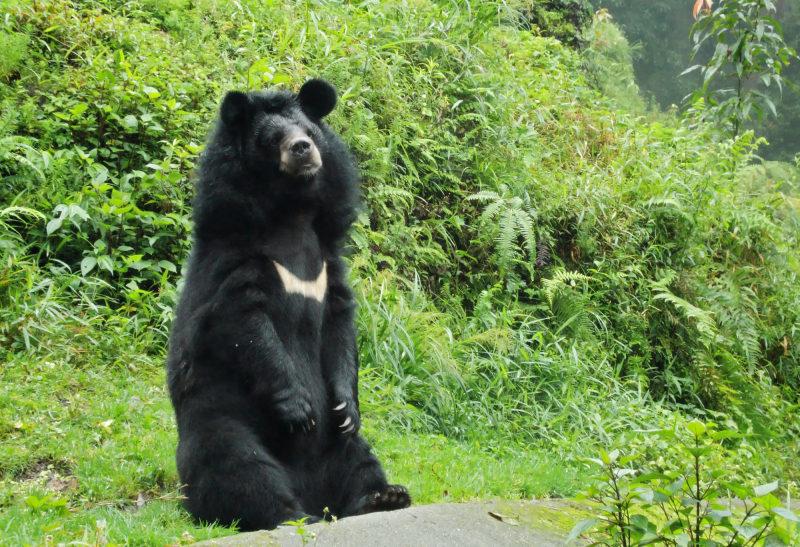Top 10 Most Incredible Animals Only Found in the Himalayas
The diversity of the Himalayan topography makes it one of the most well-known natural environments for animal species in the world. The Himalayas are known for ... read more...being cold, but they also have a variety of climates and vegetation types, including tropical, subtropical, temperate, and alpine regions. There are over 300 different mammal species in the Himalayas, in addition to countless numbers of different birds, reptiles, fish, and amphibians. Here is a list of incredible animals only found in the Himalayas, let's find out!
-
The snow leopard is probably the most amazing animal found in the Himalayas. This beautiful gray leopard can be found in the Indian Himalayas and other rocky mountains of Central Asia. The snow leopards are specially adapted to life in harsh environments of the Himalayas.
The body heat of snow leopards may be perfectly balanced in all seasons because of their thick gray hair. An adult snow leopard can weigh up to 75 kg and range in length from 30 to 50 inches. They have such strong legs and bodies. so that they may ascend the rocky mountain slopes with ease. The snow leopards can cover a distance of 15 meters in a single jump. They are perfectly balanced thanks to their lengthy tails. The snow leopard's paws are also ideal for moving through the snow. Their paws are large and have fur on the undersides. Additionally, it reduces heat loss and offers the ideal grip for navigating steep inclines.
The snow leopards can be found between 250 and 6000 meters above sea level in the summer. They will descend to the lower elevations throughout the winter. Strong hunters are the snow leopards. They mostly hunt blue sheep, marmots, and hares in the Himalayan region.

Via: World Wildlife Fund 
Via: Daily Sabah -
The Himalayan blue sheep is a high mountain sheep found in the Himalayan ranges of India, Nepal, China, and Pakistan. They are known as "Bharal" in India and "Naur" in Nepal. At a height of 400–600 feet above sea level, the Himalayan blue sheep prefer to reside in rocky hills.
The Himalayan blue sheep can weigh up to 75 kg and range in length from 3.8 to 5.5 ft. They have a short, thick coat that is blue-tinged and gray. They could blend in with the Himalayan rocks because of their distinct coat color. The Himalayan blue sheep employ this hiding tactic when threatened by predators like snow leopards. To blend in with the rocky surroundings, they don't move. As a result, it is challenging for the predator to see the sheep.The Himalayan blue sheep can be discovered in herds of ten or more animals. They prefer to forage in high altitudes where there is plenty of grass. Most of the time, Himalayan blue sheep graze. However, when there is little grass on the mountain slopes, they also eat herbs and shrubs.

Via: Wikimedia Commons 
Via: Pinterest -
Yaks are large, robust creatures with rounded, cloven hooves, powerful legs, and long, highly dense fur that hangs lower than the belly. These animals are often found between 3000 and 5000 meters above sea level. Domestic yaks can be fairly diverse in color, frequently having patches of rusty brown and cream, although wild yaks are typically dark, blackish to brown in coloration. They have short ears, broad foreheads, and smooth, typically dark-colored horns. The horns of males (bulls) bend forward after sweeping outward from the sides of the head. Usually, they are between 19 and 39 inches (48 to 99 cm) long.
When automobiles are not available, it is one of the main forms of transportation. Milk is used to manufacture a variety of bakery goods, including cheese. They also use it for fibers and meat. They are also a favorite among visitors who frequently go on yak safari in the Himalayan hills. Don't miss the brisk desert ride on this enormous creature.

Via: Stocksy 
Via: iStock -
The main threats to musk deer, a shy, timid, nocturnal, and forest-dwelling species of Himalayan animals, are poaching and the illegal traffic in musk pod, which is used to make traditional remedies and perfumes The majority of musk deer habitats are mountainous and forested, and they only consume grasses, flowers, and leaves as food. Because it prefers to stay distant from human habitation, the Musk Deer is a severely poached animal and finding it will require an arduous expedition.
The Moschidae family includes the Himalaya Musk Deer. In order to prevent poaching and manage habitat, it is essential to establish strong conservation strategies. The initial goal was to comprehend musk deer habitat ecology and latrine use behavior in the Neshyang valley, Manang, Annapurna Conservation Area (ACA) high Himalaya of Nepal in order to develop a target species-specific conservation plan.

Via: Mongabay 
Via: Wikipedia -
Himalayan black bears are also known as Asiatic black bears, and they may be found in Nepal's highland protected areas including Langtang National Park, Kanchenjunga Conservation Area, and Shivapuri National Park, Shey Phoksundo National Park, Sagarmatha National Park, and others.
A typical adult Himalayan black bear weighs up to 120 kg, measures 54 to 65 inches in length, and has a faint yellow crescent on the chest. However, the number of Himalayan black bears has drastically dropped as a result of deforestation and hunting. The exact number of bears cannot be calculated due to insufficient research. Mountain bears in the Himalayas are adept climbers. On tree limbs, they burn for the large bulk of the day. By bending the branches, they also built dwellings inside the trees. The wild bears of the Himalayas spent the middle of the year in high districts at elevations of 10,000–12,000 feet.
In any event, they fall to the lower level of their native surroundings when winter appears. The colder months of the year are spent sleeping by Himalayan wild bears. In order to increase their body's layers of fat before winter arrives, they consume foods heavy in fat. Wild bears in the Himalayas are omnivorous animals. They consume roots, nuts, honey, and small creatures.

Via: Wikipedia 
Via: Telegraph India -
Red Panda, a small but beautiful creature, has reddish-brown fur, a long, shaggy tail, and a waddling gait due to its shorter front legs; it is roughly the size of a domestic cat though with a longer body. These endangered Himalayan species are smaller and are more commonly referred to as red foxes. They have the body of a cat and the head of a panda.
The eastern Himalayas are home to this little arboreal mammal. It prefers to dwell in temperate regions among deciduous and coniferous forests, where it feeds on a variety of foods like fruit, acorns, roots, eggs, birds, and insects. This is in contrast to other mountain animals. It is a solitary species that spends most of its time active at night and resting during the day. Other names for it include the red cat-bear, the red bear-cat, and the smaller panda. Due to habitat degradation, poaching, and fragmentation, the Red Panda population is in danger of going extinct. So, the next time you go on an expedition to the Himalayan Jungle, try to find them perched on bamboo trees.
Via: Wikipedia 
Via: University of Kent -
The Himalayan Monal/Impeyan Pheasant, a magnificently colored member of the pheasant family, is Nepal's national bird. The male Himalayan monal is distinguished by its distinctive metallic-colored plumage, which includes shades of blue, green, purple, and red. Because of its dazzlingly vibrant feathers, it is known as the "nine-colored bird". Another distinguishing characteristic of the male monal is the metallic green crest. They also have a purple back, bluish-black wings, and a neck that is reddish-brown. According to reports, the species is polygamous; males have been seen mating with multiple females. The male monal attracts the female bird during the mating season using calls and physical displays including bobbling the crest and fanning the tails.
It is widely distributed throughout Nepal's Himalayan regions, from Darchula in the west to Kanchenjunga in the east. They have been well conserved by Nepal's conservation zones and Himalayan National Parks. You can observe them while hiking in the Himalayan foothills, particularly on the steep mountain slopes between 6880 and 14800 feet above sea level.

Via: Wikipedia 
Via: eBird -
A close relative of the wild goat, the Himalayan Tahr is found in the Himalayan ranges of Northern India, Nepal, and Southern Tibet. Males have a coarse, tangled mane covering their necks, chests, and shoulders. The horns of the male Himalayan Tahr, which can grow up to 46 cm long and point backward, are shorter and less pointed than those of the females.
They have a thick undercoat underneath their lengthy, earthy-colored outer coat. It helps keep their bodies warm in a frigid environment. Their jacket becomes more elongated and lighter in shade in the spring. As a result, the Himalayan Tahr can perfectly regulate its internal temperature during the entire season. Another amazing feature of the Himalayan Tahr is its hooves. The smooth, rubbery centers of the hooves provide excellent hold. The Himalayan Tahrs can therefore unquestionably wander along the majestic mountainsides.
The Himalayan Tahr weighs 40–85 kg and reaches a height of 4–5.5 ft. Compared to male Tahrs, female Tahrs have more subdued horns. The men compete with one another for the female by using their powerful horns. 20–26 Tahrs make up the herd as they move. They fled along the sides of the high mountains as soon as they recognize the hazards. In essence, their diet consists of bushes, spices, and grass.

Via: Encyclopedia Britannica 
Via: Wikipedia -
Wild boars are medium-sized mammals that are primarily found in the lower, hilly regions of the Himalayas. A wild boar can reach a length of 4 to 6.5 feet and weigh up to 200 kilograms as an adult. Wild boars have thick coats that might be brown, black, grey, or red in hue.
The wild boar is a shy animal and strives to remain undetected. Additionally, because they are nocturnal, it is very uncommon to see them during the day. Tusks on the bottom lip are the wild boar's most defining characteristic. Male wild boars have longer tusks than females do. During mating season, which lasts from November to January, the male wild boars engage in tusk-based combat to win the female. They only emerge at night to gather food and spend the daytime sleeping for about 10 to 12 hours. As omnivores, wild boars consume berries, nuts, roots, insects, and carrion in addition to other foods.

Via: The Times 
Via: iStock -
One of the highest elevation mammals in the world, the marmot lives in the Himalayan regions of India, Nepal, and Pakistan, mainly between timberline and snowline, at heights of 3,500 to 5,200 m. These regions frequently see temperatures between 8°C and 12°C, which is normal for animals living in arid alpine meadows with minimal precipitation.
Alpine meadows, grasslands, and desserts are just a few of the dry, open habitats where Himalayan marmots can be found. The Northwestern Himalayan alpine shrub and meadows ecoregion contains a large portion of their habitat. Stunted evergreen shrubs and patches of woodland dominated by birch make up the majority of the vegetation in this ecoregion. This ecosystem, which is dominated by shrubs, transforms into open alpine meadows at higher elevations.
The Hoary marmot, Yellow-bellied marmot, and the woodchuck are close relatives. The dark chocolate-brown coat of Himalayan marmots contrasts with bright yellow patches on their cheeks and chest. According to the IUCN Red List of Threatened Species, it is categorized as Least Concerned.

Via: Wikipedia 
Via: CGTN































